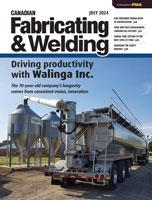- FMA
- The Fabricator
- FABTECH
- Canadian Metalworking
Hybrid method makes difficult-to-cut materials easy to cut
Researchers: Non-traditional energy-assisted machining processes may aid aerospace production
- July 1, 2024

Non-traditional energy-assisted mechanical machining may improve material removal rate and surface quality, reduce process forces, and prolong tool life in processing difficult-to-cut materials. Phuchit/iStock/Getty Images Plus
Difficult-to-cut materials such as titanium alloys, high-temperature alloys, metal/ceramic/polymer-matrix composites, hard and brittle materials, as well as geometrically complex components such as thin-walled structures, microchannels, and complex surfaces, are widely used in aerospace manufacturing.
Nevertheless, many problems exist in mechanical machining, including severe and rapid tool wear, low machining efficiency, and poor surface integrity.
A study published in the International Journal of Extreme Manufacturing by researchers from Nanjing University of Aeronautics and Astronautics explains the field of non-traditional energy-assisted mechanical machining, a promising technology for aerospace engineering.
The study, “Non-traditional energy-assisted mechanical machining of difficult-to-cut materials and components in aerospace community: a comparative analysis,” by Prof. Wenfeng Ding, Guolong Zhao, Biao Zhao, Lianjia Xin, Zhiwen Nian, Jianhao Peng, Ning He, and Jiuhua Xu, gives readers an understanding of how the innovative hybrid method will affect the manufacturing of aerospace parts.
Specifically, it discusses the processing principles, material responses under non-traditional energy, resultant forces and temperatures, material removal mechanisms, and applications of these hybrid processes. It also provides a comprehensive summary of both the advantages and limitations of each hybrid process as well as future perspectives on forward design, device development, and sustainability.
Energy-Assisted Machining
Non-traditional energy-assisted mechanical machining is a hybrid process using non-traditional energies (vibration, laser, electricity) to improve the machinability of local materials and decrease the burden of mechanical machining.
In this process, mechanical machining is the main technique for material removal, which is assisted by non-traditional energies having significant positive effects on the material removal process.
This technology provides a feasible and promising way to improve material removal rate and surface quality, reduce process forces, and prolong tool life in processing difficult-to-cut materials and components.
The transformation from difficult to cut to “easy to cut” is achieved by using non-traditional energy to change the tool-workpiece contact condition as in vibration-assisted machining, soften or modify the local material as in laser-assisted machining, control the tool kinematics as in magnetic and chemical-assisted machining, or upgrade the process condition as in advanced coolant-assisted machining.
Optimal outcomes can be achieved by means of applying appropriate non-traditional energy to assist mechanical machining while considering the characteristics of both the material and the energy.
“For example, we proposed a novel hybrid process of laser-induced oxidation-assisted mechanical machining in which a pulsed laser is utilized to induce an oxidation reaction between the irradiated workpiece material and oxygen. This resulted in the formation of loose and porous oxides, which could be easily removed with the cutting tool,” said Prof. Guolong Zhao. “However, not all the materials can be processed with this method; for example, some oxide ceramics, which cannot be further oxidized, and glasses, which have very low absorption rate of laser.”
Despite progress in non-traditional energy-assisted mechanical machining technology, some specific challenges remain unaddressed.
“There is still a significant challenge promoting the wide application of this technology in the aerospace community. For example, it is still difficult currently to apply laser-assisted mechanical machining to process geometrically complex structures. Collaborative cooperation between the laser scanning and cutting tool movement should be taken into consideration,” said Guolong Zhao.
“For vibration-assisted mechanical machining, it is crucial to enhance the performance of vibration processing equipment and provide innovative tools compatible with ultrasonic vibrations,” added Dr. Biao Zhao.
To overcome these issues, the most effective and innovative way is to conduct process-forward design and develop intelligent equipment.
“The term hybrid here is not just a simple combination of non-traditional energy with mechanical machining, forward design is mandatory in order to achieve an optimal match between the technology and processing demands in terms of efficiency, quality, and cost. Besides, the development of intelligent equipment for non-traditional energy-assisted mechanical machining is mandatory in order to promote wide application of these technologies,” said Prof. Wenfeng Ding.
The aerospace industry is continuing to push the envelope when designing parts made from difficult-to-cut materials that are able to operate in extremely harsh environments. This requires growth in the way these parts are produced.
“It is still a long way to go for this hybrid method from laboratory to factory,” said Prof. Ding. “Future works on fundamental research, technical breakthrough, and equipment development are required. It is a leading crossing discipline, which covers many fields, such as mechanics, physics, chemistry, and material science. Wide-ranging interdisciplinary collaborations are necessary to promote the wide application of non-traditional energy-assisted mechanical machining technology in the aerospace community.”
subscribe now


Keep up to date with the latest news, events, and technology for all things metal from our pair of monthly magazines written specifically for Canadian manufacturers!
Start Your Free Subscription- Industry Events
IMTS 2024
- September 9 - 14, 2024
- Chicago, IL
WiM Summit 2024
- October 6 - 9, 2024
- Boston, MA
FABTECH 2024 Orlando
- October 15 - 17, 2024
- Orlando, FL




















